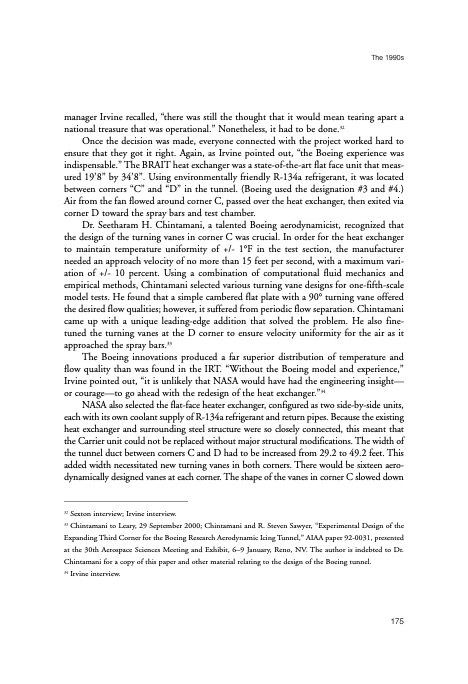
PDF Publication Title:
Text from PDF Page: 186
manager Irvine recalled, “there was still the thought that it would mean tearing apart a national treasure that was operational.” Nonetheless, it had to be done.32 Once the decision was made, everyone connected with the project worked hard to ensure that they got it right. Again, as Irvine pointed out, “the Boeing experience was indispensable.” The BRAIT heat exchanger was a state-of-the-art flat face unit that meas- ured 19’8” by 34’8”. Using environmentally friendly R-134a refrigerant, it was located between corners “C” and “D” in the tunnel. (Boeing used the designation #3 and #4.) Air from the fan flowed around corner C, passed over the heat exchanger, then exited via corner D toward the spray bars and test chamber. Dr. Seetharam H. Chintamani, a talented Boeing aerodynamicist, recognized that the design of the turning vanes in corner C was crucial. In order for the heat exchanger to maintain temperature uniformity of +/- 1°F in the test section, the manufacturer needed an approach velocity of no more than 15 feet per second, with a maximum vari- ation of +/- 10 percent. Using a combination of computational fluid mechanics and empirical methods, Chintamani selected various turning vane designs for one-fifth-scale model tests. He found that a simple cambered flat plate with a 90° turning vane offered the desired flow qualities; however, it suffered from periodic flow separation. Chintamani came up with a unique leading-edge addition that solved the problem. He also fine- tuned the turning vanes at the D corner to ensure velocity uniformity for the air as it approached the spray bars.33 The Boeing innovations produced a far superior distribution of temperature and flow quality than was found in the IRT. “Without the Boeing model and experience,” Irvine pointed out, “it is unlikely that NASA would have had the engineering insight— or courage—to go ahead with the redesign of the heat exchanger.”34 NASA also selected the flat-face heater exchanger, configured as two side-by-side units, each with its own coolant supply of R-134a refrigerant and return pipes. Because the existing heat exchanger and surrounding steel structure were so closely connected, this meant that the Carrier unit could not be replaced without major structural modifications. The width of the tunnel duct between corners C and D had to be increased from 29.2 to 49.2 feet. This added width necessitated new turning vanes in both corners. There would be sixteen aero- dynamically designed vanes at each corner. The shape of the vanes in corner C slowed down The 1990s 32 Sexton interview; Irvine interview. 33 Chintamani to Leary, 29 September 2000; Chintamani and R. Steven Sawyer, “Experimental Design of the Expanding Third Corner for the Boeing Research Aerodynamic Icing Tunnel,” AIAA paper 92-0031, presented at the 30th Aerospace Sciences Meeting and Exhibit, 6–9 January, Reno, NV. The author is indebted to Dr. Chintamani for a copy of this paper and other material relating to the design of the Boeing tunnel. 34 Irvine interview. 175PDF Image | History of NASA Icing Research Tunnel

PDF Search Title:
History of NASA Icing Research TunnelOriginal File Name Searched:
sp4226.pdfDIY PDF Search: Google It | Yahoo | Bing
NFT (Non Fungible Token): Buy our tech, design, development or system NFT and become part of our tech NFT network... More Info
IT XR Project Redstone NFT Available for Sale: NFT for high tech turbine design with one part 3D printed counter-rotating energy turbine. Be part of the future with this NFT. Can be bought and sold but only one design NFT exists. Royalties go to the developer (Infinity) to keep enhancing design and applications... More Info
Infinity Turbine IT XR Project Redstone Design: NFT for sale... NFT for high tech turbine design with one part 3D printed counter-rotating energy turbine. Includes all rights to this turbine design, including license for Fluid Handling Block I and II for the turbine assembly and housing. The NFT includes the blueprints (cad/cam), revenue streams, and all future development of the IT XR Project Redstone... More Info
Infinity Turbine ROT Radial Outflow Turbine 24 Design and Worldwide Rights: NFT for sale... NFT for the ROT 24 energy turbine. Be part of the future with this NFT. This design can be bought and sold but only one design NFT exists. You may manufacture the unit, or get the revenues from its sale from Infinity Turbine. Royalties go to the developer (Infinity) to keep enhancing design and applications... More Info
Infinity Supercritical CO2 10 Liter Extractor Design and Worldwide Rights: The Infinity Supercritical 10L CO2 extractor is for botanical oil extraction, which is rich in terpenes and can produce shelf ready full spectrum oil. With over 5 years of development, this industry leader mature extractor machine has been sold since 2015 and is part of many profitable businesses. The process can also be used for electrowinning, e-waste recycling, and lithium battery recycling, gold mining electronic wastes, precious metals. CO2 can also be used in a reverse fuel cell with nafion to make a gas-to-liquids fuel, such as methanol, ethanol and butanol or ethylene. Supercritical CO2 has also been used for treating nafion to make it more effective catalyst. This NFT is for the purchase of worldwide rights which includes the design. More Info
NFT (Non Fungible Token): Buy our tech, design, development or system NFT and become part of our tech NFT network... More Info
Infinity Turbine Products: Special for this month, any plans are $10,000 for complete Cad/Cam blueprints. License is for one build. Try before you buy a production license. May pay by Bitcoin or other Crypto. Products Page... More Info
| CONTACT TEL: 608-238-6001 Email: greg@infinityturbine.com | RSS | AMP |